If you are a connoisseur of analogue audio, it’s probable you might have a turntable and a stack of records at home somewhere. If you are of a certain age you may even have a cassette deck, though you’re more likely to have abandoned that format some time in the 1990s. If you are old enough to have been around in the 1960s or 1970s though, you may have owned another analogue audio format. One of several that you might have found in a well-equipped home of that period was the 8-track stereo cartridge, a self-contained tape cassette format that fit four stereo tracks onto a single quarter-inch tape loop as eight parallel tracks, four each of left and right. A triumph of marketing, really, it should more accurately have been called 4-track stereo.
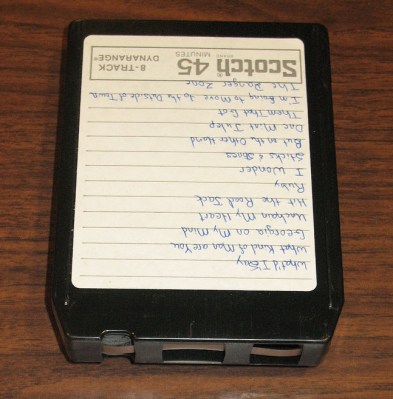
8-track cartridges were developed from earlier tape cartridge formats, largely to satisfy the demands of the automotive industry for interchangeable in-car entertainment. Thus if you owned an 8-track player it was most likely to have been found in your car, but it was not uncommon to find them also incorporated into home hi-fi systems. Thus we come to our subject today. Our retrotechtacular series usually highlights a video showing a bygone technology, but today we’re going to get a little more hands-on.
Some time in the early 1990s, I acquired an 8-track player, a BSR McDonald unit manufactured in the UK and dating from the early 1970s. BSR were much more well-known for their turntables, so this is something of an oddity. Where I found it has disappeared into the mists of time, but it was probably at a radio rally or junk sale. I certainly didn’t buy it because I wanted it to play 8-track tapes, instead I wanted a talking point for my hi-fi, something quirky to set it apart from everyone else’s. So every incarnation of listening enjoyment chez List for the last quarter century has had an 8-track player nestling within it, even if it has never played a tape while in my ownership. Thus we have a unique opportunity for this retro teardown.
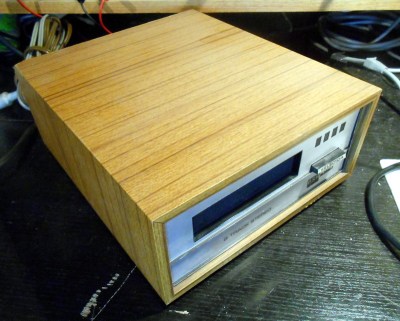 The player itself is about half the size of a normal hi-fi unit, instead of the normal roughly a 19 inch rack size it’s about 9 inches (23 cm) wide and 4.5 inches (11.5 cm) high. The outer case is made from fibreboard covered in stick-on wood-effect vinyl as was the fashion of the day, and the front panel has the cartridge slot and track selector button. On the rear panel is an audio level control and the cables, the audio output is brought to a DIN plug instead of the phonos we’d more commonly find today. There was a period in the 1970s when DIN connectors were where it was at when it came to audio.
The player itself is about half the size of a normal hi-fi unit, instead of the normal roughly a 19 inch rack size it’s about 9 inches (23 cm) wide and 4.5 inches (11.5 cm) high. The outer case is made from fibreboard covered in stick-on wood-effect vinyl as was the fashion of the day, and the front panel has the cartridge slot and track selector button. On the rear panel is an audio level control and the cables, the audio output is brought to a DIN plug instead of the phonos we’d more commonly find today. There was a period in the 1970s when DIN connectors were where it was at when it came to audio.
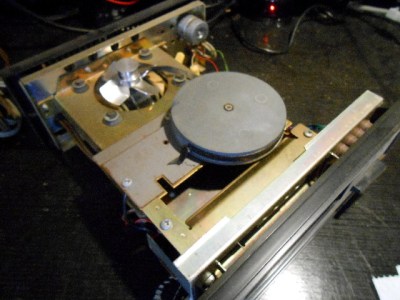
Turning the unit over, unscrewing the feet allows the cover to be slid off to reveal the mechanism. A very solid sheet steel chassis is revealed, with a mains-powered shaded pole motor and a belt drive to a substantial cast aluminium flywheel on the pinch roller shaft. The motor is also the mains transformer for the electronics, a characteristic BSR cost-saving trick that you would also have found in record players of the period.
Immediately, an unfortunate side-effect of an ancient piece of equipment became apparent, in the decades since this player was last used the drive belt has softened and turned to a sticky black tar-like substance. This is very common in belts from the 1970s, I’m told it has something to do with how well the rubber was cured. An interlude of picking, rubbing, and scraping with tissue paper ensued, along with my hands getting covered in black gunk before a trip to the sink for a date with some industrial hand cleaner.
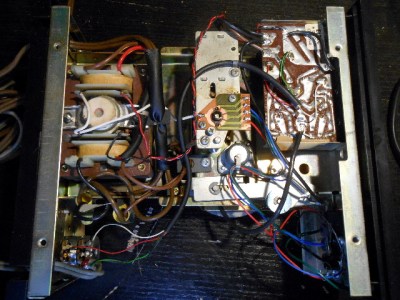 Upon inspection the chassis is revealed to be in two parts held together with self-tapping screws. The front half is the 8-track mechanism, while the rear holds the motor and the circuit board. It’s possible that this is because the same basic mechanism was used in a range of BSR products, though the 8-track format didn’t really take off in the UK it’s likely BSR would have sold this mechanism to other manufacturers in the same way they did for their turntables.
Upon inspection the chassis is revealed to be in two parts held together with self-tapping screws. The front half is the 8-track mechanism, while the rear holds the motor and the circuit board. It’s possible that this is because the same basic mechanism was used in a range of BSR products, though the 8-track format didn’t really take off in the UK it’s likely BSR would have sold this mechanism to other manufacturers in the same way they did for their turntables.
Turning the chassis over, along with the electronics and the motor, we see the business end of an 8-track player, the solenoid and mechanism that allows it to change tracks. There is a cam that is rotated incrementally through four positions by a solenoid, this cam moves the head up and down between the tracks. There are two ways the solenoid can be triggered, either through pressing the selector button on the front of the unit, or by a piece of conductive foil at the join of the tape loop passing a pair of electrical contacts to automatically change tracks. To show the operation of the cam I’ve recorded a video in which the solenoid is actuated with a pair of tweezers and the cam can be seen rotating.
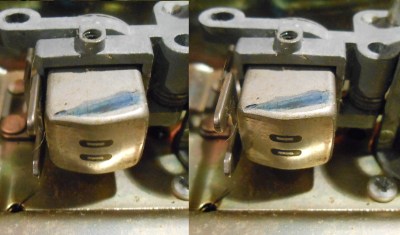
Meanwhile on the other side of the chassis, the head moves up or down by a corresponding amount. Since the width of the tape is only 1/4″ there isn’t much movement, but you can see from the relative positions of the shadows of the head in the two pictures how it moves up between the different tracks. The head itself incorporates two individual heads, one for each channel, as you can see these are spaced about a half-tape-width apart.
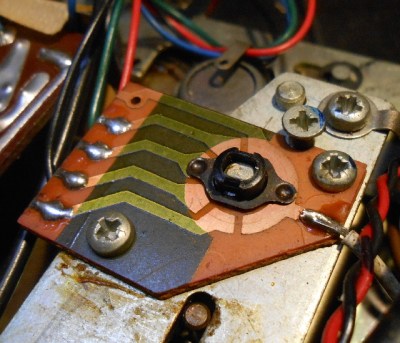
On the bottom of the shaft for the cam is a PCB switch with a wiper that traverses four pads, one for each track. This routes power to one of a set of four indicator lights on the front panel that show the currently selected track. The indicator lights are not the LEDs we’d expect today, but tiny incandescent bulbs. An LED was probably a bit too exotic for the early 1970s.
Finally, the preamplifier circuit is a collection of early-1970s discrete components on a typical resin-bonded-paper board of the era. The artwork has obviously been laid out the old-fashioned way using crepe paper on acetate, giving it very much a feeling of its era. Since the unit hasn’t seen power in many decades, it’s quite likely that its electrolytic capacitors will have deteriorated somewhat.
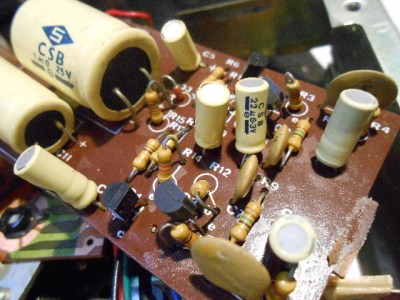
The impression I came away from this machine with was of how complex it was while simultaneously doing so little. The sheer number of individual assemblies contained within it must have made it quite an expensive device to manufacture, all of which could have contributed to it not being a commercial success here in the UK where it didn’t have the backing of carmakers to put it in new models in the way it did in the USA. It’ll go back into my hi-fi rack, and eventually there will come a point at which people ask “What’s that?” rather than exclaiming with glee because my hi-fi contains an 8-track player.

Before we leave this topic there is a final thing to examine, the 8-track cartridges themselves. They contained a continuous loop of tape wound onto a single one-sided reel, and since the tape thus had to pass over itself as it fed from the centre of the reel they used special lubricated tape with a graphite backing. They could therefore only go forwards, no rewinding was possible. The pinch roller was incorporated into the cartridge, from where it would mate with the capstan in the player. the central opening was where the head met the tape, and that on the left was where the contacts for the tape end foil sensor met the tape.
In a sense the 8-track stereo cartridge was doomed from the moment it was launched, for its nemesis, the compact cassette, had already reached the market. The cassette offered more capacity and the ability to rewind in a smaller package, and did not suffer the 8-track’s problems with head alignment due to the movement on track changes. Over the 1970s the cassette won the battle of the tape cartridge formats, aided by far smaller players incorporated into car radios and eventually into the wildly successful Sony Walkman and similar portable music players. By the 1980s there were still major releases in the format, but by the end of the decade it had faded into history, only being revived as an ocasional gag in movies.
We’ll leave you with another video, this time an advert from a time when an 8-track player was a cool accessory for your car. It’s a bittersweet one, for of course not only has the format passed into history, now also has the store selling it.
















Whats the deal with the low resolution pictures? 640×480?
Is to remember the old days of internet… 8-tracks brings nostalgia and so should low-res pictures. Aghhh!
That WAS high resolution!
Only thing higher was Hercules Graphic adapter at 800×600-in monochrome…
Kids these days… in my day we had 640×350 in 16 colours and LIKED it!
Young whippersnappers! When I finally got color, it was 320 X 240 in 4 colors. For many years before that, it was 80 X 25 character mode with some extended ASCII block and line drawing characters. Before that I had 40 characters on 16 lines. Before that, I had papertape and a teletype. My 50 baud modem was acoustically coupled.!
Oh yeah, and my tapes came on reels, and had to be manually threaded!
Spoiled punks…. Try 16 level GREYSCALE! Pictures? Had to hollow out an HP plotter pen, mount an LDR in it and feed it to a DMM hooked to IEEE-488 bus to make my own scanner, just to see something different than that Shuttle CAD drawing. MY computer had Pat Benitar on it!
Oh yeah?!y pictures were HAND DRAWN ????
Fred Flintstone
Yes, the cassette was better tan 8-track, but 8-track was incredibly popular. Endless low end stereos with players, lots of car audio that played them. Columbia House even had an 8-track tape club. Someone was buying them.
I have seen used 8-track tapes in recent years, a trickle, but I don’t remember a large number on the used market. I think I just didn’t notice, nothing would make me buy them, but maybe they weren’t there. Maybe by the time people were tossing, the secondary market wasn’t there.
I suspect one thing, if someone started buying them, they probably felt locked. So they’d buy a player for home, and keep buying tapes, rather than restart in another format. Though maybe for some, they just wanted the latest hits, so once that album had finished its shelf life, it no longer mattered, so no need to keep playing them.
A while back, and maybe it is ten years now, I came upon a garage sale with a reel to reel tape deck. It was something decent, for stereo rather than language labs. And only ten dollars. And I stood there for a while, thinking about how I’d lusted for one, and what I might have done with it once, and realized the only reason to have it now was as a collector’s item. And I left it, carrying it home was more trouble than spending ten dollars on it.
But, next to it was an 8-track recorder. Those were never that common, and my vague memory is that they came relatively late in the life of the medium, late seventies. Sort of a novel item, and smaller to carry, and only five dollars. And I left it there, no practical use for it, and not much excitement to have it as a museum piece.
Michael
You should have bought the reel to reel, I remember as a kid my Grandfather had a reel to reel and an 8-track, I took an 8-track cassette apart (how I didn’t get in trouble I don’t know) and threaded the tape onto the reel to reel and I got to listen to all the songs on the tape at once!
Heard of Octomed and/or impulse tracker?
What you describe would be like thosee audio trackers but on old analogue magnetic tapes.
I recall many references being made to 8-track and reel-to-reel in the Reggae, Jungle and associated Pure-rave (Oldskool Prodigy like music) type scenes (Some other scenes as well…. Possibly some types of older hiphop?).
Modified for effects like echo, delays, 8-track sampling to 1 track (two track stereo) for final cuts, etc….
Heck these tapes (Reel-to-reel & 8Track) had essentially more sample* space, more track time and twice the tracks of the Amiga OCTOMED! However probably was a pain to work with, especially if the artist messed up on a track.
*Pseudo sample in the case of magnetic media.
should really say popular in USA.
Geez! 8-track… nostalgia for some really good times… feels like visiting a grave.
Fun Fact:- The 8-track was invented by William Lear, of Lear Jet fame.
And didn’t he have a four track system before? You could get Lear tape decks for the car.
Michael
George Eash invented the 3 track Fidelipac cartridge in 1954 for radio stations. Earl “Madman” Muntz, working with Eash, developed the 4 track Stereo-Pak. William Lear took that and made the 8 track.
Fidelipac and Stereo-Pak had the problem of having a big pinch roller hole in one side of the housing. That required a plastic or cardboard sleeve to keep dust out and the players had to have a mechanism to elevate a pinch roller into the cartridge.
By incorporating the pinch roller into the cartridge, Lear’s 8 Track allowed for simpler players and also for a simple plastic clip to be used on the cartridges for keeping out dust and protecting the tape. It also made more room on the back side of the tape for album info and track listings. The downside of having the pinch roller in every tape was the rollers tended to vary in quality, some tapes used bare plastic rollers. Then there is the problem of deterioration. The material used in some of the pinch rollers turns to goo over time.
For a couple of years after the introduction of 8 Track there were players capable of using both 4 track and 8 track tapes. I assume the more sophisticated ones has some sort of sensing which tape type was inserted and would automatically hit the track change twice since 4 track has only two programs, like a Compact Cassette, and the heads would be 1/2 as wide on the 8 track head used in the dual format player.
It is an interesting time in audio history, with parallels to much later digital technology. Adding the pinch roller to the cartridges is like a very primitive version of how Nintendo expanded the capabilities of the NES and SNES by adding additional processor chips to some cartridges. Playing both 4 track and 8 track tapes in the same player? Every DVD player does audio CD and DVD. Or perhaps Fidelipac = Video CD, 4 track = DVD, 8 track = HD-DVD, Compact Cassette = Blu-Ray, crushing all other formats. Nevermind that 8 Track lasted much longer than HD-DVD.
And then there’s this. ;) https://www.youtube.com/watch?v=6HBvS6ucGso
+1 “Not many people know that!”
The 8-track format is a consumerized adaptation (by Lear) of the broadcast cartridge used by radio stations for ads and music; the differences are: in the broadcast cart the pinch roller came up through a cutout in the cartridge; the 8-track has a built-in pinch-roller, which makes the decks smaller and cheaper to make. And also, in the broadcast cart deck, the head doesn’t need to jump up and down.
A single (stereo) track version of the 8 Track (e.g. everything but the mechanism that moved the heads up/down) was used for many many decades in radio stations as the medium of choice for commercials. The foil strip on the tape that makes the head move in an 8 Track was used as the start/stop marker. Push a button, the commercial plays, foil hits the contacts in 30 seconds and it stops the motor. Two allowed you to cascade them at the 0/15/30/45 minute commercial breaks.
There were even radio stations that used four (or more) of them tripping each other in sequence to do overnights without having to pay for on air talent. You could tell because the music played in the same order several times every night.
Those audio “cart” machines were also widely in TV & recording studios for spot effects, and jingles. They came in multiple of 2 or 4, and one show I worked 16 (4 x 4s) to do the music stings for a game show. It was replaced by a keyboard sampler with an effect or music sting on each key!
Broadcast carts didn’t have foil, they used tones for marking the start of the recording and for other cues such as end of recording, to trigger another device.
Subaudible tones. Stop was 25 hz and was just before the begining of the track (because it was a loop). Carts came in common lengths of ads, but musoc carts could be miscued if the DJ removed them before the loop ended.
Jenny, a real bit of nostalgia. During the mid-70s a friend had an 8-track in his Datsun (now Nissan) Z240.
I had forgotten about the mains transformer in the motor! I remember those record players.
It was a crappy format mainly because a song would be playing, then quickly fade, you’d hear the machine go ‘ka-click’, then the song would fade back in. Weak!
And then there were those foam “pressure” pads, a few summers and goo… self destruct mode. Oh and the matchbook jammed into the slot with the tape to get traction on that graphite strip. The capstan was acid etched to grip but it became as slick as it wore out.
Too bad as it was the only quadraphonic format that really worked. Philips nixed the quad cassette and quad sank into history. It made studios master much music in The Decade in quad format. The ’70’s would be in quad we hoped.
Rerel-to-reel quad (4 tracks on 1/4″ tape) works just fine, but the decks were like $700+ in the 70s and 80s. And not many releases in that format.
I still have my Realistic Quad receiver/amp. It works quite well with some Y’s on the input sending the same content to two rooms with separate volume controls.
Just don’t ever, EVER, EVER put it in bridge mode using the switch in the back. It was supposed to double the power output on the Left/Right speaker jacks. Instead, it would overheat the transistors, the nylon screws holding them to the heat sink would melt. Then the solder would melt, the transistor leads would slide down through the holes in the PCB. If you were lucky, the solder would stick to the legs and eventually disconnect the transistor. If not, it burned a nice transistor sized hole in the board.
Radio Shack bought a lot of these back. If you knew someone in a Repair Center, you could get one with some creative repairs. :)
Melting nylon screws! Good lord man. Thanks for the heads up ;) Staying away from bridge mode.
been wanting to convert all my black metal to 8 track to make it extra kvlt. but ive yet to find a working 8track player.
You want something worthy, try this…
http://1stopretroshop.com/item-photos/retro-vintage-sparkomatic-8track-cassette-tape-adaptor-1stopretroshop-w511142-2.jpg
+
http://g01.a.alicdn.com/kf/HTB1vK0yKFXXXXa4XXXXq6xXFXXXq/Free-Shipping-Auto-Car-Cassette-Tape-Adapter-for-MP3-MP4-Phone-Connect-your-CD-Player-MP3.jpg
+
https://support.apple.com/content/dam/edam/applecare/images/en_US/ipod/ipodclassic/psp-hero-ipodclassic.png
Now that is kul!
Ahh well, you know how they work now… tear down a newer cassette player and get hacking. :-)
I’m sure a few 3D printed parts, and you’d have a leadscrew-based assembly to move the head up and down on, the rest is simply having the motor turning at the right speed with a flywheel to reduce the wow factor.
Classi Movie moment-
Iron Eagle
Kid jumps into his car and pushes in an 8 track concerted tape into his 8 track car stereo so he could listen to his sony Walkman… sheer classic!
in the 70’s I was the proud owner of a record-able 8 track player. I think I might still have it. I kept it as it was the only one I’ve ever seen.
I’m not sure how many 8 track decks I repaired over the years (damn I’m old) Or for that matter how many Cassette players owe there life to me. 8 track decks were a much simpler mech. than cassette decks. And at first where much higher fidelity. Only because of the size of the tracks. That didn’t last long though, and though the mech’ was tougher than cassette, the tapes themselves were not. After a short time 8 traps tapes would spit out the tape. Cassette tapes, although the players would break more often, the tapes survived longer.
Yes I did service a few BSR tape decks. But the transformer in the motor didn’t fly here, not CSA approved. The din plug on the back would also identify it as a European model. Though some did make it over here.
You’re leaving out the best part of it: the 8-track cartridge was the pinnacle of 1970s design. Imagine, if you will, running this sandwich through a mechanism: rubber roller, graphite-backed polyester tape with iron oxide bound to the other side using a very questionable binder, then a piece of sticky-back tin foil that in most tapes acted as the loop splice, and finally a steel capstan. So every time the splice came around you’d get a tiny bit of adhesive from the back of the foil tape transferring to the pinch roller, but the roller was covered with graphite so the glue didn’t stick to that, so it found its way around the edges of the tape to the capstan, where at some point after either the first hot summer day or the 40th playing of the tape, would cause the tape to adhere to the capstan, wrapping itself around and around until it filled up all of the available space around the capstan OR stretched the tape to the breaking point inside the cartridge. The first indication that this was about to happen was that you’d start to hear a flutter or warbling in the music, and if you were very quick and very lucky, and pulled the tape out as soon as you heard this, you might get all of the tape out and save your deck by cleaning the capstan with a long q-tip and some alcohol, but you could never trust that tape again. But more often, by the time you pulled the tape out, it was firmly attached to the capstan, so it just pulled the tape out of the cartridge.
A very common sight on the sides of highways in the early 1970s was a big snarl of 1/4″ tape, because the most common reaction to this by angry drivers was to yank whatever they could out of the player and toss it out the window.
I well remember seeing those! Also 8 tracks had to slice and dice song order to fit into 4 (semi) equal chunks so they didn’t play in the same order as the LP you had at home, and don’t forget hearing the song on the other track leaking through during quiet portions due to head misalignment. I have fond memories of car units which required the careful insertion of a match book under the cartridge for optimal head alignment, kind of like the penny on the tone arm on the fold out plastic stereo back at home, those were the days (not).
No rose-colored glasses on THIS thread!
Every so often I think about how I don’t see big rolls of tape on the side of the road any more… or broken CD-Rs either!
So how do they do a transformer / motor combo? Something to do with coils, I think for starters.
I assume it’s the same way they did it on a slide projector I once owned, made by Rollei in Germany: the projector used a 24V 100W halogen lamp, so they made the fan motor with a lot of extra iron and a tapped winding that both powered the fan and stepped down the voltage for the lamp. And that WAS sold in the U.S., with a UL listing.
In an 8-track deck, this would have been much easier, since the current draw of the electronics would be much lower. But the principle’s the same: you just tap the motor winding for whatever voltages you need for the electronics.
And then there’s the trick still used on cheap hair dryers, which is kind of the opposite thing: they tap the heating coil and run that through a diode so they can use a cheap low-voltage DC motor for the blower.
I was a bit surprised that both these have bridge rectifiers but then I thought it was just easier to get the high RPM with a brushed DC motor. The one’s blower is like my least favorite kind of computer fan: most of its ~2.5″ diameter is the hub and the blades are barely 1/2″ so those ear-killing RPM are mandatory :(
As the other commenter said, a shaded-pole induction motor is not unlike a transformer without a secondary, so they add a secondary. What you get out isn’t necessarily clean though.